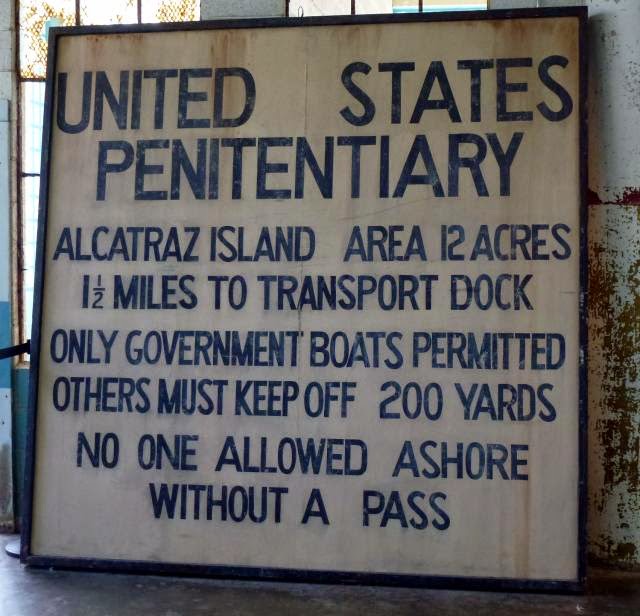Alcatraz lies in
San Francisco bay 1½ miles off-shore. Soon after California became part of the
USA in 1848, Alcatraz was turned into a military fortress and then in 1867/8 became
a military prison. In 1933 the US Dept. of Justice took it over as a federal
penitentiary to house the country’s most difficult convicts. The first
prisoners were installed in 1934, and the jail served in that capacity for the
next 29 years. The island was totally self-sufficient, with a power generation
plant, food processing, laundry etc. Water was shipped over in bulk.
The next photo is
taken from the boat taking us to Alcatraz and shows the island’s rocky profile
and isolation, making it an ideal prison location. The bay waters are cold
throughout the year, so discouraging an escape attempt by swimming. The prison
block is the building right on the top of the island.
Official business only! This notice greeted all who approached too close.
This was a
no-nonsense prison. Warders were called correction officers and tight
discipline was enforced with armed guards patrolling from behind a barred
gallery so they could not be overpowered and their weapons seized. They were
guarding these three-tiered cell corridors, of which there were three main corridors
and an isolation block. This is the central corridor known as Broadway.
Individual cells
throughout looked like this. They housed major criminals like Al Capone, Alvin
“Creepy” Karpis, and “Machine Gun” Kelly.
“D” Block, or the
isolation section, was reserved for the most troublesome prisoners. The most
famous of these was Robert Stroud, the “Birdman of Alcatraz”. He spent all of
his 17 years here in isolation due to his extremely violent history, including
killing a prison guard for which he narrowly missed the death penalty. This is
the “D” Block
Yet Stroud was a
very intelligent man who had become a world expert on canaries at his previous
prison where he finally killed the guard and got transferred to Alcatraz. He
was denied access to his bird studies as part of his punishment. This is what
Stroud looked like.
There was a more
severe regime available in “D” Block: the “Hole”. These were solitary
confinement cells where a restricted diet and total darkness was sometimes
applied. Those deemed to deserve such treatment were held there for several
days, up to a maximum of 19.
There was a daily recreation
period, to be taken in the exercise yard. Bridge was especially popular and the men stayed
outside for the full term of several hours even in the bitter cold. The yard
looks a forbidding place, as you can see. Reminds me of my old school
playground.
There were 14
separate escape attempts and the official line was that no convicts made it.
The bloodiest attempt was in 1946 when three convicts and two guards died.
The attempt in 1962
was, and still is, the most intriguing. Three prisoners made dummy heads for
their beds so that the guards saw them “asleep” when they made their regular inspections.
Supposedly in bed, they headed up a ventilation shaft that led out onto the
roof. They had with them 50 rubber raincoats from other inmates that made into a
raft, and wooden paddles scrounged from other sources. They planned to climb
down from the roof, reach the sea, and paddle away.
The official
version is that they drowned, but no bodies were ever found, although bits of
the raft and paddles were discovered on the shore of another island in the bay.
However, there were reported sightings of the men for many years afterwards and
the families claimed to have received postcards in the men‘s handwriting. The
US Marshall’s file will remain open until they all reach the age of 100.
The prison closed
in 1963 and lay abandoned for 6 years until occupied by Native Americans
demanding just treatment for the return and self-government of Indian
territories. They were there for two years. This high water tower is still inscribed
with slogans for their cause that sought to generate public sympathy. Their
campaign was partly successful and a turning point in the government’s attitude
to Indian administration within their own lands. The Prison Governor’s old
residence was accidentally burnt down during their occupation.
Another kind of protest was taking place on Alcatraz during our visit, this
time with official approval. Art activist Ai Weiwei was exhibiting a set of dissidents’
faces from repressive political regime. They are all made from Lego and are
divided into world sections. He himself can’t leave China for his political statements
through his art. So he’s a kind of prisoner, exhibiting the faces of many who
are in prison, in a prison. Very appropriate.
This final photo sums up, for me, the chilly, moody atmosphere of
Alcatraz, looking from the island towards the misty Golden Gate Bridge over a
grey, cold sea.














































